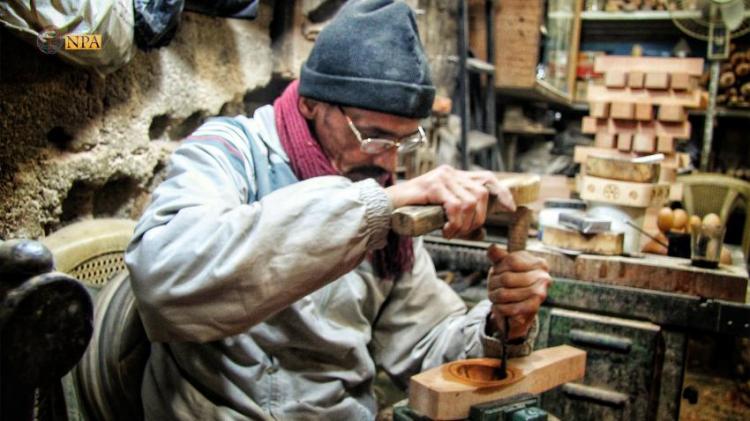Handicrafts in Damascus from ancient history to war victims
Damascus – North-Press Agency
Safaa al-Sallal
Handicrafts at the time confer a touch of beauty to Damascus, one of the oldest cities in history, to keep industries threatened with demise, as a source of livelihood for many people, and as an important source of tourists’ attraction, because of the skill and technology of manufacturing them.
Dozens of handicrafts are scattered in most of the old neighborhoods of Damascus, and in the neighborhoods of Tekkiye al-Sulaymaniya, Khan Basha, Bab Touma and others, and some of them conferred their own touches on them and named with their names.
Lanterns and laminated wood
North-Press toured the market of handicrafts in Damascus, which was divided into many parts, including the manufacture of chandeliers and lanterns.
Artisans and workers in this profession confirmed that, the manufacture of lanterns originated since the Mamlouk era in the thirteenth century, and was limited to the manufacture of small lamps.
They added that the artisans developed and introduced new amendments, including beads, copper, glass and crystal, until it became an international craft, and decorated the streets of Damascus, even the houses of the old city.
While the artisans of the inscription on the “Ajami” wood, derived the forms used in the inscription from the architectural and artistic heritage of the different historical periods, which passed over the city, such as the Ayyubid, Mamlouk and Fatimid periods and others.
The workers told North-Press that they use most of the engraving work, as parts of the wooden furniture for the Damascene houses, which is considered as unique artifacts for the quality of its manufacturing.
Glass and brocade
The hand-made glass has excelled by popular artists and artisans, from blowing it to adapting in the kilns of mud and brick with liquid crystal.
This industry, according to its artisans, originated from the fourteenth and fifteenth centuries, which is characterized by precision and skill in coloring or glaze, and varied forms, decorations and multi-color paint, and the most famous types of ceramics are the local ornamentation ceramics with glossy metallic luster.
While artisans in the Damascene brocade profession said that it was made of linen, cotton, wool, hair and silk.
The brocade products are displayed in the fashions of the Hall of Folk Fashion at the famous Damascene al-Azem Palace, which contains many hand-embroidered clothing such as dresses, trousers, vests, tissues, hats, tobacco bags and money.
While workers in this profession said that the brocade industry dates back to about three centuries in Damascus and Aleppo, the two largest Syrian cities, which specialized in silk brocade with golden, silver and concise threads, and with unique drawings and decorations, while today it is used for upholstery and making luxury bags.
Damascene clog
Damascene clogs still have a special place in Damascus, which is unique in its industry, where it is made of walnut and willow trees whose trees are abundant along Barada River. It is mainly sold in al-Qabaqebiya market in Old Damascus.
The artisans asserted that they continue to manufacture them in good quantities, as clogs are still used in public baths in the old part of the city, and there is a luxurious clog displayed at al-Azem Palace, which was used in traditional weddings.
Reasons for the decline
The handicraft markets seemed almost empty. Vendors and workers in the profession told North-Press (preferring not to be named), that the majority of handicraft markets remained almost empty because of the war, which significantly affected them.
They stressed that some craftsmen preferred to migrate rather to stay in Damascus and continue their work within their profession, and that the deteriorating economic conditions in addition to the attention of most customers to keep pace with the development in the world of war and fashion, others kept them away from handicrafts and products.
While the artisans of the old markets of Damascus said that, the reason for the decline of their handicrafts, is the high prices of the raw materials, first of which is wood and the wages of the workers, in addition to the difficulty of marketing products and the lack of adequate attention from the concerned authorities to the owners of the crafts, despite the need to preserve and embrace these crafts as they reflect the history of Damascus.

